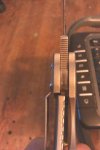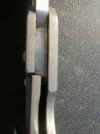Few links for ya. By the way, its not just Strider folders but all of this type in general that contact at the bottom. Trying to make the entire lock contact the blade is usually going to create a situation where the lock contacts more in one area than another where you can end up with rolling of the blade on the lock to some degree giving you that feeling that something is giving during use because well, something is. Ideally you want it rock solid with three points to steady the blade when locked open. The stop is one point, the pivot the other, and the lock up the last for a triad of contact to stabilize the blade but it doesn't stop there. You can see in the links one aspect of how the lock connects to the blade. Note the gap on both the Emerson and Strider knives shown in those two links. This is technically correct for how to build this style of folder. Now we move past that aspect to the actual contact surface area looking at the bottom of the lock contact head on and based on current ideas regarding the pitch angle for the contact on the blade or simply the area made in the blade where the lock connects, you can see that most will contact the blade on the inside corner at the bottom of the lock making for what amounts to a very small surface area that is actually in contact with the blade at any time. To a lot of folks this is somewhat surprising considering the locks look so big and impressive. (see pic)
The pic I've attached shows the contact grind or milled area at an angle formed into the blade as it is normally seen in most folders of this type. The current trend seems to be geared toward concave type lock contacts whereas in knives from about 10 years ago most were seen as flat more like older Benchmades from the early to later 90s and even the Sebenza as it comes today. Chris Reeves seems to be one of the few in the industry to still do things the same way he always did in regards to the contact. To my knowledge Chris found what worked and stuck with it never changing how he does things again. Benchmade does their contacts for their mono locks and liner locks today like this Spyderco Military frame lock and like Emerson but knives of yesteryear have a different looking contact. Even my 98 Emerson Specwar folder has a different looking contact in both the angle and how it appears looking at it compared to my newer Emersons. Does this mean they have made some improvements? I guess it does. While I can't be certain of how they did this or why it seems yesteryears knives used a flat platten to make the contact on the blades and today's contacts have some type of wheel to make the contact. As to the diameter of said wheel, well, I'm betting thats probably going to vary in type and diameter from company to company and maker to maker just like the pitch angle will.
If you save theses picture to your hard drive in my pictures or my documents and then find them both you can then zoom in and see what I'm referring to as to how the lock on most today contact at the bottom inside corner. You are looking down at the bottom of the lock here. Note that the inside corner at the very bottom is mostly where your conatact is at on the lock. As for how far that goes upward toward the detent ball well, thats anyones guess and can vary from model to model. As for how much of that inside corner touches the blade regarding the width of the lock well, again that can vary also. Remember we are looking at the lock as if it goes in a cross. + It goes up and down for vertical as well as horizontal so to say this again. How much lock contacts vertically is anyones guess. I try on mine to spread that out to at least 3mm squeezing 5 mm on some. How much contacts horizontally is again, depending on how much time you spend developing that contact on each knife you make. Again I try to spread that aspect out pretty well too. Even doing this the actual foot print from knife to knife even in the same model can vary widely and the wear pattern over time will show you just how big the foot print of the contact is. We've all see them when we've taken the knives we own of this type apart to clean them. Again, in my experience the more surface area you can spread out over that safe zone to make the contact the longer and better the lock will wear and it will usually bind and stick less when the contact is spread out some.
As is always the case there are other things that contribute to these things like the pitch of the contact angle. With one like that pictured you have more inside corner contacting. If say the contact was a flatter pitch angle you could actually have more of the lock contacting and you would not see that space to the left looking down like you do in this picture but as this angle is actually steeper you get the contact on just that inside corner. What may or may not occur from that is that the lock may travel in faster or seem to, sticking some all the while usually and it may even seem to wear faster but you'd have more lock physically contacting the blade too so its kind of just a matter of what the maker thinks is best or what the machine they are working on is pre-set at to do this particular part of the job. Most lock contacts seem to be pitched at a bout 7 degrees plus or minus. 6 to 8 is fine in my opinion. 10 degress will work but anything over that in my opinion, especially in thinner easier to influence (meaning easier to manipulate) locks like thinner liner locks, then the steeper pitched angles are an accident waiting to happen because what you see is the lock slide toward release either from spine pressure steadily placed on a locked open blade or from spine taps. The idea with steeper pitch angles seems to be to keep the lock from traveling in or all the way across the tang so quickly with the idea being if the angle is such that the lock can't really go much further then the knife won't need serviced as quickly. At least I guess that was the motive for the concave lock contact when it came about. Anyway, a lot of speculation on my part I know but its just what I see looking at what is sent to me in the way of many production and custom knives spanning years in the industry.
People ask me what I like myself all the time and personally my take is that I just like it to work. I do most all my lock contacts on a 10" wheel at 7 to 8 degrees for the setting on my table for pitch. See second picture. As you can see my contact being flatter does not exhibit the same amount of 'gap' because more of the lock on my knife comes into contact with the blade. I can only hope you can see what I'm referring to for 'gap' by looking to the left of the Military frame lock at that space in front of the lock between the blade contact and the lock face. The bottom line is that on the Ouparator (right thumbnail) the lock is contacting the blade for a bigger foot print both vertically (looking at the lock like the links show in the Emerson and Strider) and horizontally looking at it as shown for the thickness of the lock. You can see (I hope) that the knife I made is contacting the blade on more than just the inside corner of the lock when compared to the lock on most production folders as the are shipped. It doesn't mean either of them is done wrong. Again, both are technically done correctly. Its just that my take on the aspect of lock making of this type anyway is that a 3 mm x 3 mm or 4 mm by 4 mm foot print for actual physical contact to the blade will naturally wear better and longer than a 1 mm x 1 mm surface area at the very bottom inside corner of the lock.
My hope is that even if my trying to convey with words what I'm picturing in my mind causes folks to say, what, you lost me Steve!? Maybe the pictures will be worth a thousand words and just simply convey it visually for you. I hope that makes sense. I'm sure it goes without saying that to do this extra effort of spreading out the contact with every knife takes time so it is unlikely you'll see that kind of time spent on the lock of most production folders. In my opinion though this is one of the things that stands out to me as to why Chris Reeves knives is a stand out in the industry. He takes the time to adjust and fit these parts to be just so and thats what you pay for and what you get for your extra dollars. In this regard Chris' production knife is a stand alone as I see no other that can claim to be done as well or as consistently in production folders. Customs are a different story and some of the customs being built today show a good bit of development in contact technology trying to make them as good as they can be. Note in the pictures I've posted the gap to the left of where the lock actually contacts the blades. If you look close you will see that there is a gap to the left of the actual part of the lock that contacts the blade on each photo. The difference is the amount of gap and even then its not a whole lot so we are talking micro sizes when you stop to think about it but that little bit of diff in a folder can make a lot of diff in the way it feels and behaves in the hand as well as how the lock wears.
STR
http://www.bladeforums.com/forums/showthread.php?t=653509
pic:
http://www.bladeforums.com/forums/attachment.php?attachmentid=135735&d=1245285445
pic:
http://www.bladeforums.com/forums/attachment.php?attachmentid=135734&d=1245285404

